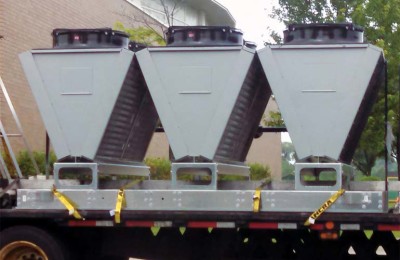Refrigerant leaks will close some natatoriums

Michelini says the school could have postponed the dehumidifier retrofit another five years; however, the R-22 refrigerant-based units were leaking regularly, which increased maintenance costs. Since R-22’s chemical makeup includes chlorine, a major leak and total refrigerant loss of either unit would have damaged the environment and strained the school district’s budget. Further, replenishing a total charge of R-22 refrigerant would cost a minimum of $20,000, as its prices are increasing as the U.S. Environmental Protection Agency (EPA) continues to phase out hydrochlorofluorocarbons (HCFCs) until the complete ban in 2020.
The strategy of reducing potential environmentally damaging refrigerants also enhances the school district’s aggressive green mission, which typically includes annual carbon footprint reductions aimed at cutting energy use by three to five per cent annually.
The R-22 debacle is prompting many indoor pool facility mangers to replace their outdated dehumidifiers for fear of a catastrophic leak. All refrigeration coils, whether in a residential five-ton central air conditioner or an 80-ton commercial dehumidifier, will likely leak at least once in its lifecycle. Therefore, as R-22 prices increase due to dwindling supply and the fact the majority of dehumidifiers manufactured before 2006 likely use it, a total loss of refrigerant from a leak at medium to large natatoriums could cost upwards of $40,000 in replacement costs alone. Hopefully, for the commercial indoor pool operator, a total loss of a large unit will not bankrupt the centre or force it to close temporarily until repair funds are secured.
This potential for leaks is driving many indoor pool operators to prematurely replace their R-22 dehumidifiers with modern units, which use 80 per cent less refrigerant. The little refrigerant they do use (R-410A) is environmentally acceptable and significantly less expensive.
Another consideration for retiring older units prematurely is efficiency. Today’s technological advancements are more efficient than their predecessors 20 or even 10 years ago. The emergence of direct-drive fans versus belt-driven fans, electronically commutated motors, exhaust heat recovery, and other technology can be the deciding factor in retiring an older dehumidifier simply because the payback in energy savings can be substantial.







Indoor swimming pools rooms create their own environment and can be be a big problem when trying to control mold, mildew and dampness. That’s why you need an excellent ventilation and / or dehumidification system. This is something that home owners overlook the seriousness of when thinking of building an indoor pool.